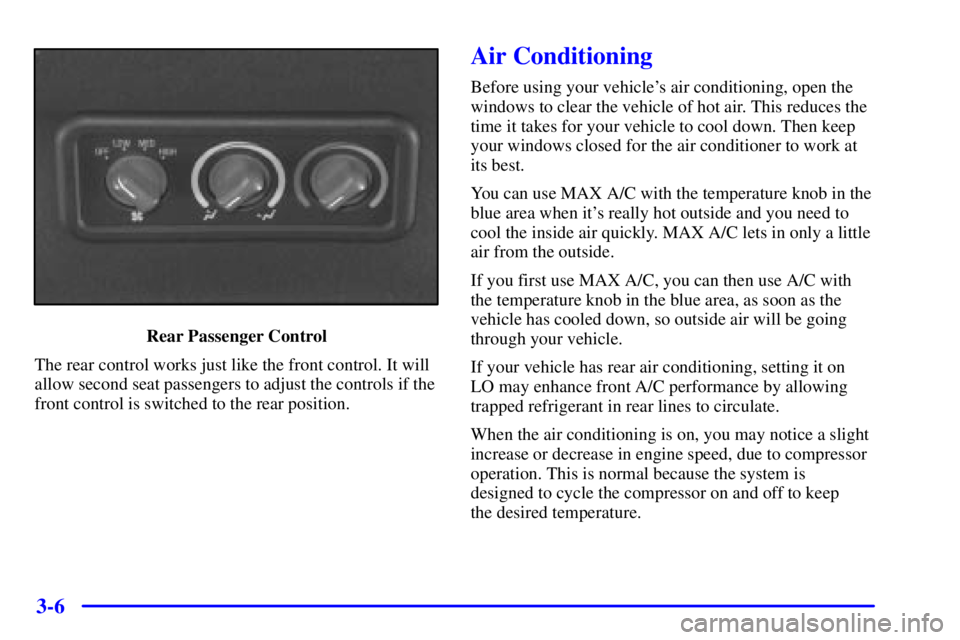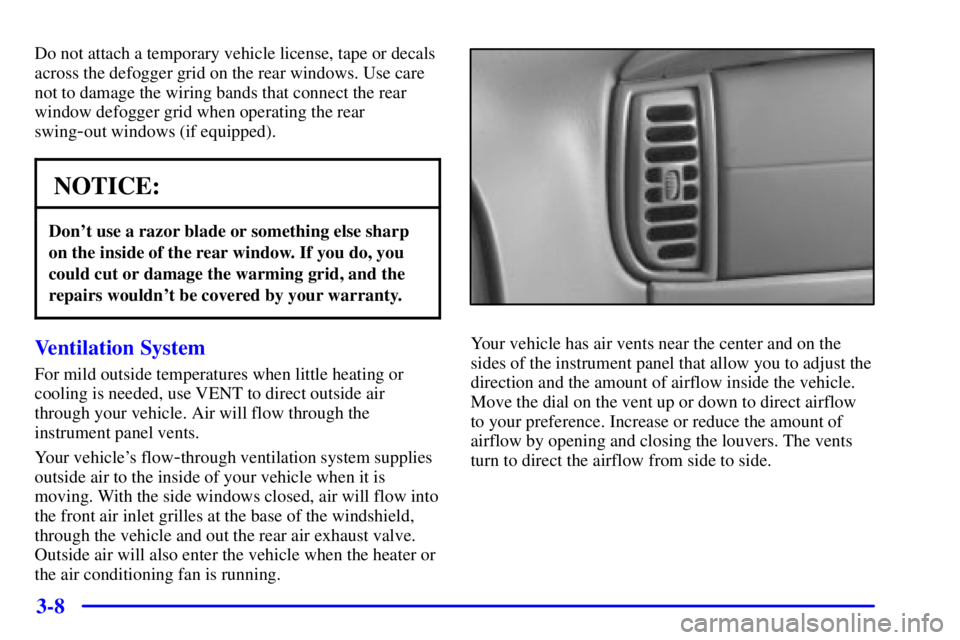Page 122 of 412
2-45
Heated Outside Rearview Mirrors (If Equipped)
Your outside mirrors can be
defrosted by pressing the
button near the fan control.
An indicator light on the button will be lit anytime the
heated outside rearview mirrors are activated.
Your rear window defogger will be on anytime the
heated mirrors are on. If your vehicle has a rear window
defogger, see ªRear Window Defoggerº in the Index.
Convex Outside Mirror
Your passenger's side mirror may be convex. A convex
mirror's surface is curved so you can see more from the
driver's seat.
CAUTION:
A convex mirror can make things (like other
vehicles) look farther away than they really are.
If you cut too sharply into the right lane, you
could hit a vehicle on your right. Check your
inside mirror or glance over your shoulder before
changing lanes.
Page 145 of 412

3-
3-1
Section 3 Comfort Controls and Audio Systems
In this section, you'll find out how to operate the comfort control and audio systems offered with your vehicle.
Be sure to read about the particular systems supplied with your vehicle.
3
-2 Comfort Controls
3
-6 Air Conditioning
3
-7 Heating
3
-7 Defrosting
3
-7 Rear Window Defogger (If Equipped)
3
-8 Ventilation System
3
-10 Audio Systems
3
-10 Setting the Clock for Systems
without Radio Data System
3
-10 Setting the Clock for Systems
with Radio Data System
3
-11 AM-FM Stereo
3
-14 AM-FM Stereo with Cassette Tape Player
(If Equipped)
3
-19 AM-FM Stereo with Compact Disc Player
(If Equipped)3
-23 AM-FM Stereo with Cassette Tape
and Compact Disc Player with Radio Data
System (RDS) and Automatic Tone Control
(If Equipped)
3
-34 AM-FM Stereo with 6-Disc Compact Disc
Player with Programmable Equalization and
Radio Data System (RDS) (Option)
3
-44 Theft-Deterrent Feature RDS Radios
(If Equipped)
3
-44 Theft-Deterrent Feature Non-RDS Radios
(If Equipped)
3
-45 Understanding Radio Reception
3
-45 Tips About Your Audio System
3
-46 Care of Your Cassette Tape Player
3
-47 Care of Your Compact Discs
3
-47 Care of Your Compact Disc Player
3
-48 Fixed Mast Antenna
3
-48 Chime Level Adjustment (RDS Radios Only)
Page 147 of 412

3-3 Heater/Air Conditioning Controls
(If Equipped)
If your vehicle has air conditioning, your heater/air
conditioning controls will look like this.
Before using your vehicle's air conditioning, open the
windows to clear the vehicle of hot air.Fan Knob
The knob on the left side of the heating system control
panel regulates the fan speed. The knob has four speed
positions. To increase airflow, turn the knob toward HI.
To decrease airflow, turn it toward LO. To turn the fan
off, turn the mode knob on the far right to OFF.
Temperature Knob
The middle knob on the control panel lets you select the
temperature of the air flowing into the passenger
compartment of your vehicle. This knob will allow you to
adjust the air temperature independently of the function knob
setting. Turn the knob toward the red area for warmer air.
Turn the knob toward the blue area for cooler air.
Mode Knob
The right knob on the control panel changes the
heater/air conditioning setting.
MAX A/C: Turn the right knob to MAX A/C for
maximum cooling. This setting puts the system in the
recirculation mode and helps to maximize your air
conditioner's performance and your vehicle's fuel
economy. This setting also cools the air the fastest. After
the vehicle's interior reaches a comfortable temperature,
turn the knob clockwise to place the air conditioning
system in the A/C mode.
Page 150 of 412

3-6
Rear Passenger Control
The rear control works just like the front control. It will
allow second seat passengers to adjust the controls if the
front control is switched to the rear position.
Air Conditioning
Before using your vehicle's air conditioning, open the
windows to clear the vehicle of hot air. This reduces the
time it takes for your vehicle to cool down. Then keep
your windows closed for the air conditioner to work at
its best.
You can use MAX A/C with the temperature knob in the
blue area when it's really hot outside and you need to
cool the inside air quickly. MAX A/C lets in only a little
air from the outside.
If you first use MAX A/C, you can then use A/C with
the temperature knob in the blue area, as soon as the
vehicle has cooled down, so outside air will be going
through your vehicle.
If your vehicle has rear air conditioning, setting it on
LO may enhance front A/C performance by allowing
trapped refrigerant in rear lines to circulate.
When the air conditioning is on, you may notice a slight
increase or decrease in engine speed, due to compressor
operation. This is normal because the system is
designed to cycle the compressor on and off to keep
the desired temperature.
Page 151 of 412

3-7
Heating
On cold days, use HEAT with the temperature knob in
the red area. Outside air will be brought in through the
floor outlets. The heater works best if you keep your
windows closed while using it.
If you use the optional engine coolant heater before
starting your engine, your heating system will produce
warmer air faster to heat the passenger compartment in
cold weather. See ªEngine Coolant Heaterº in the Index.
Defrosting
Use DEFROST to remove fog or ice from the
windshield quickly in extremely cold conditions. The
temperature knob should be in the red area and the fan
knob toward high. The air conditioning compressor may
operate in this setting to dehumidify the air.
Rear Window Defogger (If Equipped)
If you see lines running across the rear windows, you
have a rear window defogger. The lines warm the glass.
For best results, clear the windows of as much snow or
ice as possible before using the rear window defogger.
To turn on the rear window
defogger, press this button
located near the fan control.
An indicator light in the
button will come on when
the rear window defogger
is working.
The rear window defogger will only work when the
ignition is in RUN.
The rear window defogger will turn itself off after
several minutes. If you need additional warming time,
press the button again. Pressing the button when the
indicator light is illuminated will turn the defogger off.
If your vehicle is equipped with heated outside rearview
mirrors, the rear window defogger button will activate
both the rear window defogger and the heated outside
rearview mirrors. See ªHeated Outside Rearview
Mirrorsº in the Index.
Page 152 of 412

3-8
Do not attach a temporary vehicle license, tape or decals
across the defogger grid on the rear windows. Use care
not to damage the wiring bands that connect the rear
window defogger grid when operating the rear
swing
-out windows (if equipped).
NOTICE:
Don't use a razor blade or something else sharp
on the inside of the rear window. If you do, you
could cut or damage the warming grid, and the
repairs wouldn't be covered by your warranty.
Ventilation System
For mild outside temperatures when little heating or
cooling is needed, use VENT to direct outside air
through your vehicle. Air will flow through the
instrument panel vents.
Your vehicle's flow
-through ventilation system supplies
outside air to the inside of your vehicle when it is
moving. With the side windows closed, air will flow into
the front air inlet grilles at the base of the windshield,
through the vehicle and out the rear air exhaust valve.
Outside air will also enter the vehicle when the heater or
the air conditioning fan is running.
Your vehicle has air vents near the center and on the
sides of the instrument panel that allow you to adjust the
direction and the amount of airflow inside the vehicle.
Move the dial on the vent up or down to direct airflow
to your preference. Increase or reduce the amount of
airflow by opening and closing the louvers. The vents
turn to direct the airflow from side to side.
Page 153 of 412

3-9
When you close a vent, it will increase the flow of air
coming out of any vents that are open.
If you have rear heating or rear air conditioning, you
will have adjustable vents in the rear of the vehicle to
help direct the airflow. The rear air conditioning vents
are located in the headliner at the rear of the vehicle.
The rear heating vents are located next to the second
and third seat on the driver's side of the vehicle, near
the floor. You can move the vents to direct the flow of
air, or close the vents altogether. When you close a vent,
it will increase the flow of air coming out of any vents
that are open.Ventilation Tips
�Keep the hood and front air inlet free of ice, snow, or
any other obstruction (such as leaves). The heater
and defroster will work far better, reducing the
chance of fogging the inside of your windows.
�When you enter a vehicle in cold weather, turn the
blower fan to HI for a few moments before driving
off. This helps clear the intake ducts of snow and
moisture, and reduces the chance of fogging the
inside of your windows.
�Keep the air path under the front seats clear of
objects. This helps air to circulate throughout
your vehicle.
Your vehicle has air vents in the center and on the sides
of your instrument panel.
You can move the vents from side to side or up and
down to direct the flow of air, or close the vents
altogether. When you close a vent, it will increase the
flow of air coming out of any vents that are open.
Page 214 of 412

4-22
Before Leaving on a Long Trip
Make sure you're ready. Try to be well rested. If you
must start when you're not fresh
-- such as after a day's
work
-- don't plan to make too many miles that first part
of the journey. Wear comfortable clothing and shoes you
can easily drive in.
Is your vehicle ready for a long trip? If you keep it
serviced and maintained, it's ready to go. If it needs
service, have it done before starting out. Of course,
you'll find experienced and able service experts in
GM dealerships all across North America.
They'll be ready and willing to help if you need it.
Here are some things you can check before a trip:
�Windshield Washer Fluid: Is the reservoir full?
Are all windows clean inside and outside?
�Wiper Blades: Are they in good shape?�Fuel, Engine Oil, Other Fluids: Have you checked
all levels?
�Lamps: Are they all working? Are the lenses clean?
�Tires: They are vitally important to a safe,
trouble
-free trip. Is the tread good enough for
long
-distance driving? Are the tires all inflated to the
recommended pressure?
�Weather Forecasts: What's the weather outlook
along your route? Should you delay your trip a short
time to avoid a major storm system?
�Maps: Do you have up
-to-date maps?